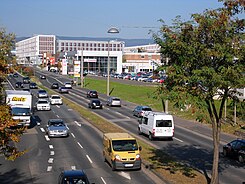Mainzer Strasse (Wiesbaden)
| Mainzer Strasse | |
|---|---|
| Street in Wiesbaden | |
| View from the south over Mainzer Strasse to the Wiesbaden justice and administration center (behind the car dealership) | |
| Basic data | |
| place | Wiesbaden |
| District | Southeast |
| use | |
| User groups | Pedestrian traffic , bicycle traffic , car traffic , public transport |
| Technical specifications | |
| Street length | 2,900 m |
The Mainzer Strasse in Wiesbaden , has its name from the fact that they originally to Mainz-Kastel led, the former right-bank district of Mainz .
Mainzer Strasse begins east of the city center as a junction to the south from Frankfurter Strasse and, after crossing under Gustav-Stresemann-Ring (1st ring - Bundesstrasse 54 ) without any intersections, it is expanded as Bundesstrasse 263 with two lanes in each direction with a bus lane and median. The 2nd ring ( Theodor-Heuss-Ring ) crosses Mainzer Straße with a bridge structure. Along with Schiersteiner Strasse and Berliner Strasse, it is one of the most important and best-developed entry and exit roads in the Hessian state capital. It connects Wiesbaden with the Wiesbaden-Mainzer Straße junction of the A 66 and with the start of the A 671 at the Mainz-Amöneburg junction . At the roundabout below the junction, Mainzer Strasse bends southwest and leads under the Gleisdreieck at Wiesbaden Ost train station to its end point at the intersection with Kasteler Strasse .
South of the 1st ring, Mainzer Strasse opens up one of the few commercial areas near Wiesbaden city center with the Terrum Tower at Mainzer Strasse 75, various car dealerships, former factories and restaurants of fast food chains and electronics stores . The development of this area was subject to profound changes in the last decades of the 20th century due to the abandonment of business premises, their demolition and subsequent redevelopment by other users. For example, the buildings of the waste disposal companies that have moved into a new complex at Dyckerhoffbruch and the buildings of the former horticultural center (there has been a justice center here since 2009) were demolished . The slaughterhouse site was almost completely razed to the ground after the slaughterhouse was closed at the end of 1990 and the last operations in the meat wholesale market were relocated in 1994. In addition to the congress parking lot for the Rhein-Main-Hallen there are only two buildings that are used as a cultural center.
Buildings in Mainzer Strasse
Former Wuth'sche brewery at the end of Mainzer Straße / beginning of the A 671
Individual evidence
- ↑ Wiesbadener Tagblatt of November 11, 2008: From the slaughterhouse to the Salzbach- Aue cultural park
Web links
- Urban Planning Office: Design of the city entrances in Wiesbaden , accessed on June 18, 2013
- Mainzer Strasse urban space. Analysis of urban development and design enhancement , PDF file 5.47 MB
- Wiesbadener Tagblatt of October 12, 2009: Even without rattling wheels CITY HISTORY Mainzer Strasse as a magnet for a wide range of businesses
- Wiesbadener Tagblatt from October 16, 2009: Way into the future NEUBAUTEN Mainzer Straße is changing its appearance noticeably






